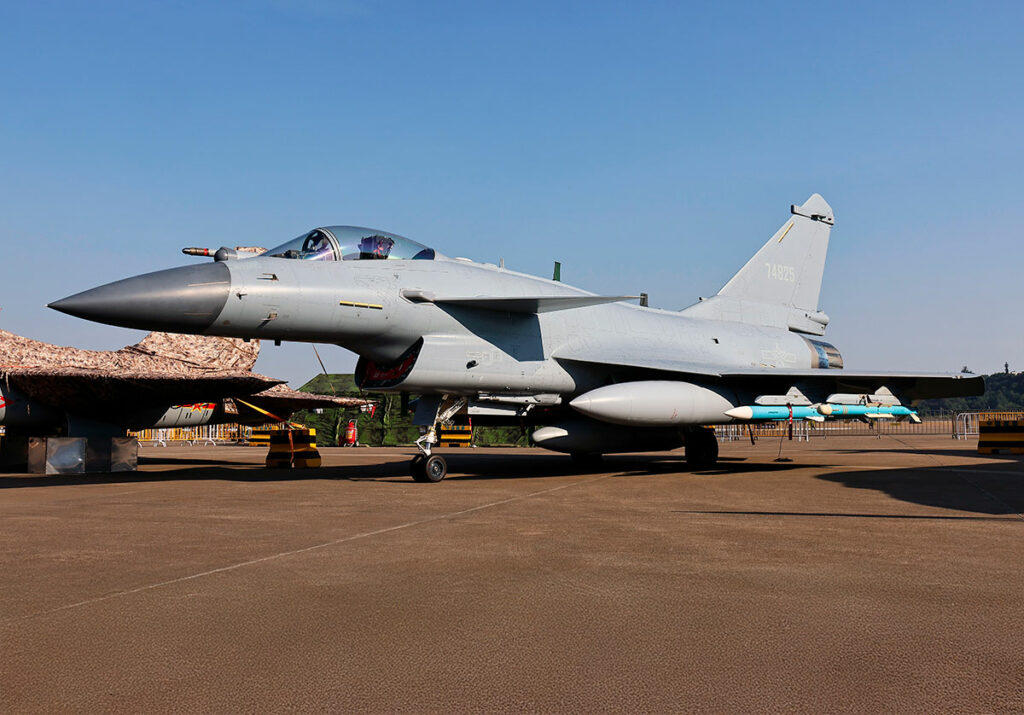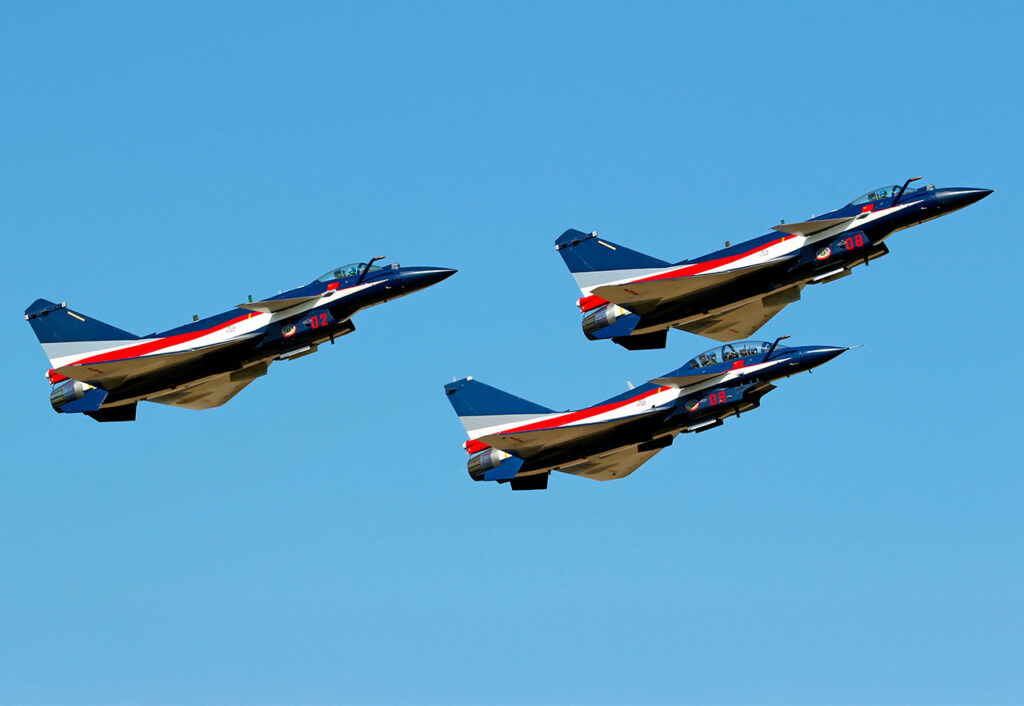The CAIC FC-20 (J-10CE) Firebird is a single-engine, single-seat, multirole, fourth-plus generation fighter jet, excelling in systematic, cooperative combat.
Technical Summary of the Aircraft
The CAIC FC-20 (J-10CE) Firebird is an advanced, single-engine, single-seat, multirole fighter jet developed by the Chengdu Aircraft Industry Corporation (CAIC). It features a delta-wing design with canards positioned ahead of midships to enhance agility. Powered by the Shenyang WS-10B afterburning turbofan engine, it achieves a maximum speed of Mach 1.8 and a service ceiling of 59,000 feet (17,985 meters). The aircraft boasts eleven external hardpoints, supporting a diverse array of armaments, including air-to-air missiles, precision-guided bombs, and rocket pods. Its advanced avionics suite includes an active electronically scanned array (AESA) radar, enhancing its combat capabilities in various mission profiles.
History of the Development of the CAIC FC-20 (J-10CE) Firebird
In the late 20th century, the global geopolitical landscape was characterized by rapid technological advancements and shifting power dynamics. For China, the need to modernize its military capabilities became increasingly apparent, especially in the realm of aerial combat. Existing aircraft in the People’s Liberation Army Air Force (PLAAF) inventory were becoming outdated compared to Western and Russian counterparts. To address this disparity, China initiated efforts to develop an indigenous fighter jet that could meet the demands of modern warfare.
The genesis of the FC-20, known domestically as the J-10CE, can be traced back to the mid-1980s under Project 8610. This project aimed to create an air superiority fighter capable of countering fourth-generation aircraft fielded by other nations. The Chengdu Aircraft Design Institute spearheaded the development, drawing inspiration from previous projects and international designs. Notably, the Israeli IAI Lavi program, which was canceled in the 1980s, influenced the J-10’s design, leading to speculation about foreign assistance in its development.
The development phase was marked by extensive research and testing. The first prototype took to the skies on March 22, 1998, with test pilot Lei Qiang at the controls. This maiden flight lasted approximately 20 minutes and represented a significant achievement in China’s aviation history. However, the journey was not without challenges. One prototype was lost due to issues with the fly-by-wire system, an incident initially denied by Chinese authorities. Despite such setbacks, the program progressed, leading to the production of several prototypes and pre-production models for operational testing.
By 2003, the J-10 had entered production, and the following year, it was delivered to a test regiment within the PLAAF. Official introduction into service occurred in 2005, marking nearly two decades of development. The aircraft was designated as the J-10A for the single-seat variant and J-10S for the two-seat trainer version. Over time, the design underwent several upgrades, leading to the development of advanced variants such as the J-10B and J-10C, each incorporating improved avionics, radar systems, and engine modifications.
The J-10C variant, which serves as the basis for the export-oriented FC-20 (J-10CE) Firebird, introduced significant advancements, including an Active Electronically Scanned Array (AESA) radar, enhanced electronic warfare capabilities, and compatibility with modern air-to-air missiles like the PL-15. These improvements positioned the J-10C as a formidable competitor in the international fighter market.
In 2022, Pakistan became the first international customer of the J-10CE, locally designated as the FC-20, bolstering its air force capabilities with this modern platform. The acquisition underscored the aircraft’s appeal to nations seeking a cost-effective yet advanced multirole fighter.
Throughout its development, the FC-20 (J-10CE) Firebird has reflected China’s growing prowess in aerospace engineering and its commitment to producing indigenous military technology capable of meeting contemporary combat requirements.

Design of the CAIC FC-20 (J-10CE) Firebird (continued)
The fuselage is streamlined, with a length of approximately 50.9 feet (15.49 meters) and a wingspan of 31.3 feet (9.75 meters). The aircraft’s structure incorporates a mix of composite materials and high-strength alloys to reduce weight while maintaining structural integrity. This ensures durability under high-G maneuvers and combat stress.
The cockpit features a bubble canopy, providing the pilot with excellent visibility, crucial for situational awareness in both air combat and ground attack missions. The digital glass cockpit is equipped with three multifunction displays (MFDs), a holographic head-up display (HUD), and Hands-On Throttle and Stick (HOTAS) controls, enabling efficient management of avionics and weapons systems.
The FC-20 employs a fly-by-wire (FBW) control system, which replaces traditional mechanical linkages with electronic controls. This system enhances the aircraft’s responsiveness, stability, and maneuverability, particularly in high-speed engagements.
The radar and avionics suite in the J-10CE is a significant improvement over previous versions. The aircraft is equipped with an Active Electronically Scanned Array (AESA) radar, allowing for superior target tracking, multi-target engagement, and enhanced resistance to electronic warfare. This radar provides a detection range exceeding 170 kilometers (105 miles), making the aircraft competitive with other fourth-generation fighters such as the F-16V and Rafale.
The electronic warfare (EW) suite includes radar warning receivers (RWRs), missile approach warning systems (MAWS), and chaff/flare dispensers, ensuring survivability in high-threat environments. The aircraft is also capable of carrying jamming pods and other countermeasure systems to disrupt enemy radar and missile guidance.
In terms of weapon integration, the FC-20 features 11 external hardpoints, allowing it to carry a diverse range of munitions, including beyond-visual-range air-to-air missiles (BVRAAMs), infrared-guided short-range missiles, precision-guided bombs, unguided rockets, and electronic warfare pods.
While the FC-20 excels in many aspects, it has some limitations. The reliance on a single-engine (Shenyang WS-10B or Russian AL-31FN) means that engine failure could be catastrophic. Additionally, while its maneuverability is excellent, it does not incorporate thrust vectoring, which limits post-stall performance when compared to aircraft like the Sukhoi Su-35.
Performance of the CAIC FC-20 (J-10CE) Firebird
The FC-20 (J-10CE) Firebird is powered by a Shenyang WS-10B afterburning turbofan engine, an indigenous powerplant developed by China to replace the Russian AL-31FN. The engine produces 13,200 lbf (58.7 kN) of dry thrust and 29,000 lbf (130 kN) with afterburner.
The aircraft achieves a maximum speed of Mach 1.8, approximately 2,205 km/h (1,370 mph). This places it in the same speed category as competitors like the F-16 Fighting Falcon and Dassault Rafale.
The operational ceiling of the FC-20 is 59,000 feet (17,985 meters), allowing it to operate at high altitudes where enemy air defenses may be less effective.
The combat radius of the aircraft is approximately 1,250 kilometers (777 miles) without aerial refueling, making it suitable for regional air defense and strike missions. The ferry range, which includes drop tanks, extends to 3,400 kilometers (2,113 miles).
The FC-20’s rate of climb is approximately 1,540 meters per second (300 feet per second), giving it rapid altitude gain, crucial in air combat engagements.
Compared to competitors, the F-16V Block 70 features a similar Mach 2.0 speed and 55,000 feet (16,764 meters) ceiling, but has an edge in terms of combat-proven capabilities and extensive upgrade packages. The Rafale, in contrast, benefits from twin-engine redundancy, superior sensor fusion, and a wider weapons payload.
Variants of the CAIC FC-20 (J-10CE) Firebird
- J-10A – The first operational variant, featuring a basic pulse-Doppler radar and AL-31FN engine.
- J-10S – Two-seat trainer version with similar avionics to the J-10A.
- J-10B – Upgraded variant with an improved radar, infrared search and track (IRST) system, and a more streamlined intake for better aerodynamics.
- J-10C – Advanced version with AESA radar, WS-10B engine, enhanced stealth features, and expanded weapons compatibility.
- J-10CE (FC-20) – The export variant of the J-10C, first sold to Pakistan Air Force.

Military Use and Combat of the CAIC FC-20 (J-10CE) Firebird
The FC-20 is armed with:
- 1x GSh-23 twin-barrel 23mm autocannon (internal)
- PL-15 long-range air-to-air missiles (BVRAAM)
- PL-10 short-range infrared-guided missiles
- LS-6 precision-guided bombs
- YJ-91 anti-radiation missiles
- KG600 electronic warfare pod
The Pakistan Air Force (PAF) became the first foreign operator of the FC-20, receiving 25 aircraft in 2022. These jets are stationed at Mianwali Air Base and are intended to supplement the JF-17 Thunder in air defense and offensive roles.
The FC-20 has not been used in major combat, but Pakistan has deployed it for air patrols and readiness exercises near the Indian border. It is expected to serve as a counter to India’s Dassault Rafale and Su-30MKI fighters.
No other confirmed exports exist as of 2025, though potential buyers include the United Arab Emirates, Egypt, and Saudi Arabia.
The CAIC FC-20 (J-10CE) Firebird is a modern single-engine, multirole fighter, integrating advanced avionics, AESA radar, and electronic warfare capabilities. It delivers strong performance in speed, maneuverability, and weapons integration, making it a cost-effective alternative to Western and Russian fourth-generation fighters. While its single-engine limitation and lack of thrust vectoring present some drawbacks, its AESA radar and long-range missile capabilities enhance its combat effectiveness. The Pakistan Air Force’s adoption of the aircraft underscores its strategic relevance in modern air combat.
Back to the Fighter Jet section.